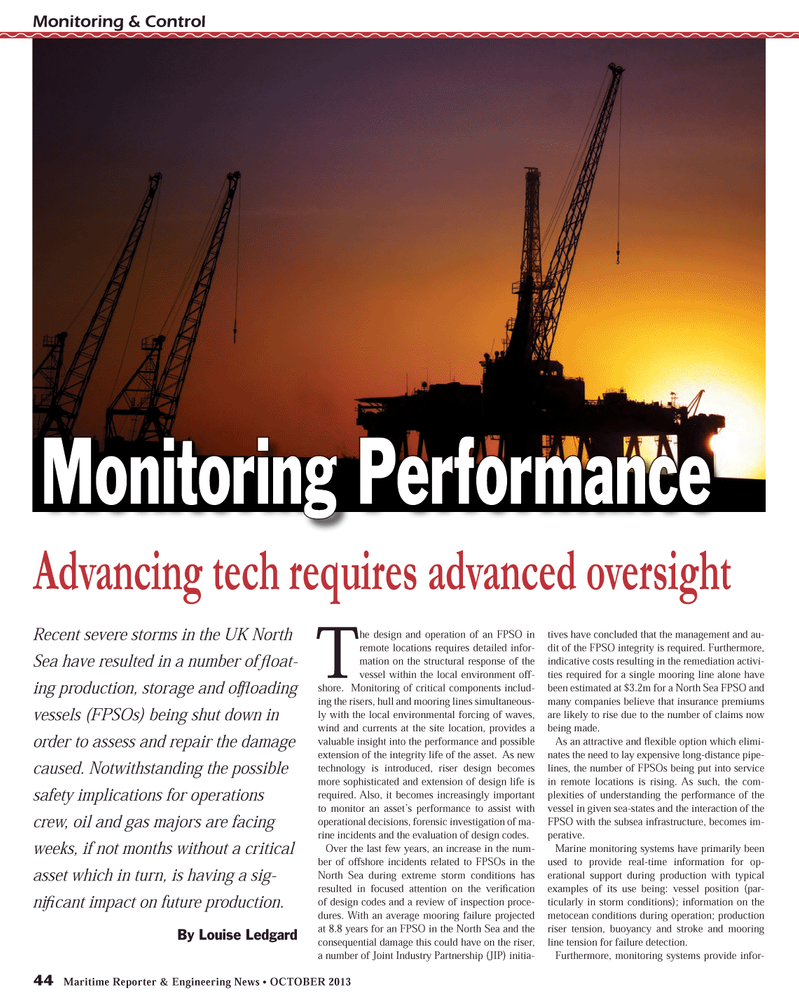
Page 44: of Maritime Reporter Magazine (October 2013)
Marine Design & Construction
Read this page in Pdf, Flash or Html5 edition of October 2013 Maritime Reporter Magazine
44 Maritime Reporter & Engineering News ? OCTOBER 2013 The design and operation of an FPSO in remote locations requires detailed infor- mation on the structural response of the vessel within the local environment off- shore. Monitoring of critical components includ-ing the risers, hull and mooring lines simultaneous-ly with the local environmental forcing of waves, wind and currents at the site location, provides a valuable insight into the performance and possible extension of the integrity life of the asset. As new technology is introduced, riser design becomes more sophisticated and extension of design life is required. Also, it becomes increasingly important to monitor an asset?s performance to assist with operational decisions, forensic investigation of ma-rine incidents and the evaluation of design codes.Over the last few years, an increase in the num-ber of offshore incidents related to FPSOs in the North Sea during extreme storm conditions has resulted in focused attention on the veriÞ cation of design codes and a review of inspection proce-dures. With an average mooring failure projected at 8.8 years for an FPSO in the North Sea and the consequential damage this could have on the riser, a number of Joint Industry Partnership (JIP) initia-tives have concluded that the management and au-dit of the FPSO integrity is required. Furthermore, indicative costs resulting in the remediation activi-ties required for a single mooring line alone have been estimated at $3.2m for a North Sea FPSO and many companies believe that insurance premiums are likely to rise due to the number of claims now being made. As an attractive and ß exible option which elimi-nates the need to lay expensive long-distance pipe-lines, the number of FPSOs being put into service in remote locations is rising. As such, the com- plexities of understanding the performance of the vessel in given sea-states and the interaction of the FPSO with the subsea infrastructure, becomes im-perative.Marine monitoring systems have primarily been used to provide real-time information for op-erational support during production with typical examples of its use being: vessel position (par- ticularly in storm conditions); information on the metocean conditions during operation; production riser tension, buoyancy and stroke and mooring line tension for failure detection. Furthermore, monitoring systems provide infor- Monitoring & ControlMonitoring PerformanceMonitoring PerformanceRecent severe storms in the UK North Sea have resulted in a number of ß oat-ing production, storage and of ß oading vessels (FPSOs) being shut down in order to assess and repair the damage caused. Notwithstanding the possible safety implications for operations crew, oil and gas majors are facing weeks, if not months without a critical asset which in turn, is having a sig-niÞ cant impact on future production. By Louise Ledgard Advancing tech requires advanced oversight MR #10 (42-49).indd 44MR #10 (42-49).indd 4410/2/2013 4:28:57 PM10/2/2013 4:28:57 PM

 43
43

 45
45
